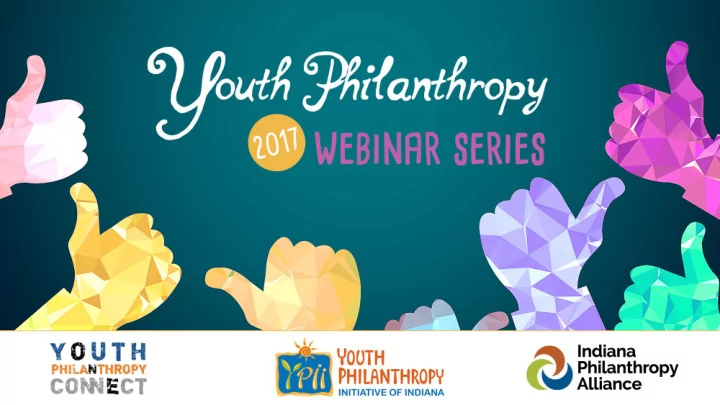

Lynn Sygiel Editor Charitable Advisors
“When Kids Wrote the Headlines” Link: WFYI.org/ce-yp
Storytelling Resources • Framing Stories for Change by Nat Kendall-Taylor • Frameworks: culture – shared patterns of thinking -- is always mediating our meaning. – You say, they think. How people use culture to think about our issues.
East 10 th Street: Miracle Place • Elementary students from the Indianapolis Near Eastside worked with high school students to create audio slideshows about life along the East 10th Street area. • A ollaboration between Y-Press and Second Story, two nonprofit organizations that work with kids on journalism and creative writing.
Audio Slideshows
Subject Matters Link: WFYI.org/ce-yp/subjectmatters
Skills • Documentary video clips for educator use Questioning Interviewing Developing story angles
Leah Goldstein Associate Director, Prozdor Director, Jewish Teen Foundation of Greater Boston
Social Media Why? What is being used? Who is our audience? Teens Adults [parents] Fellow educators [and clergy] in the community When (are we supposed to use it) ?
Examples: Highlighting Teens (with photos + quotes) on social media
Examples: Highlighting Teens Always have teens’ permission for photos and quotes [have the participant and their parents sign a waiver at the beginning of the year to cover all of your bases] Avoid stock photos on social media [real pictures of people the audience may know is much more captivating] Always include [working] links to provide more information Have partner/host organizations “share” your posts
How do we tell our story? This is the most important question [I ask my teens this at least once a week]! I say… “If you love JTFGB [our program] so much, how can you talk about it to others? Don’t you want to tell the story of it to the community? Your peers? Your parents? Your teachers? Anyone from other parts of your life?” I say… “Use your OWN voice.” As the educator and program director, people don’t want to hear MY voice. However, I still occasionally write my own blog posts (I love to write and am constantly inspired by the teens’ work, so I just can’t help myself). Everything sounds better and more interesting coming from the teens — especially if it is a program for them.
Telling Our Story… Blogging and Vlogging Find a community platform (a type of umbrella organization or website) to host your blog or have a page for your organization We use JewishBoston.com Have the teens write or record the post — but as the program director, you can take the lead of getting it on to the website to ensure it is done correctly A quick read-through and edit before it gets posted it is always a good idea As you edit it, be sure to not change the voice of the post too much and that it still takes on that of a teen Accountability: have it be a requirement for [some of] your teens to blog, vlog, share on social media, etc. as part of their participation within the program My Leadership Council teens have made a commitment to doing that this year
[Teen] Voices of JTFGB on JewishBoston.com The JTFGB page is completely customizable with different tabs [events, blogs, contact, etc.]: JewishBoston.com homepage:
Ashley Rodriguez Coordinator Youth Funding Youth Ideas
Infographics • We started using infographics in 2015 to create youth-friendly data reports. • Came across Pikto Chart ! • Pikto Chart is an easy infographic design app that requires very little effort to produce high quality graphics. • We now use Pikto Chart to create newsletter infographics, flyers, and presentations. • There is a free and PRO version. • We highly recommend folks use the PRO. Costs $40 for a year subscription
Creating an Infographic 1. Practice by using their themes first 2. Make it simple! The less info the better 3. Train your youth to use Pikto Chart 4. Be creative
Newsletter Strategy ● YFYI uses mailchimp for our newsletter ● Started with 131 subscribers and now have 431 ● 94 opens compared to 430 (duplicated) ● Mailchimp will produce reports on your newsletter activity (i.e. total opens, top subscribers, etc)
Strategy ● We release our newsletter monthly - on the 2nd Wednesday of the month between 3-5pm ● The youth in our program decide the theme of the month for our newsletter ● Content is very uniform but overtime has been simplified to include less information and more images ● Mail chimp also allows you to develop your own template ● Through trial and error AND with the help of mailchimp we figured out the time that receives the most opens Feb 2015 Sept 2017
Newsletter Content ● We make our newsletter very relevant to what is happening around us. Our newsletters have been focused on seasons (Black Lives Matter, dedicated to Mom and Fathers, Bees, YFYI changes, Standing Rock, migration, etc.). ● Content includes: ○ Opening Picture ○ Opening Description/Paragraph ○ Infographic ○ Youth/Employee Interview Spotlight ○ Resources (as needed) ○ Closing Picture
Example Name - In Bloom (with a bunch of flower emojis) Theme - Spring and Resilience
PLUS JOB RESOURCES
Elijah Washington Founder Youth Giving Back
Snapchat
Recommend
More recommend